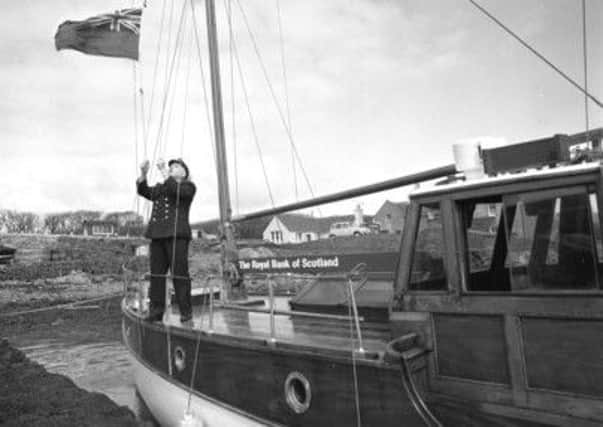World’s only floating bank to join Orkney museum


The much-loved Otter Bank served remote communities across Orkney during the 1960s, allowing islanders to manage their financial affairs without making the long journey to the mainland.
The 6.5-ton boat, initially owned by the National Commercial Bank of Scotland, which later became part of the Royal Bank of Scotland, had staff to manage transactions including deposits and withdrawals and was fitted with an on-board safe.
Advertisement
Hide AdFrom 1962 until 1970, the Otter Bank served as a seagoing bank, and on occasion an ambulance when the vessel was used to transport a pregnant mother to hospital in Kirkwall.
Skippered by Davie Irvine, the boat visited nine isles per week, with a visit to North Ronaldsay once a month.
Clerk Willie Groat carried out the bank business when they arrived in their destination, sometimes in shore offices in the larger isles, but often aboard the vessel itself.
The Otter was immortalised on film in 1967 when the National Commercial Bank of Scotland made a publicity documentary, Bank Ahead, which showed her and her crew.
The bank was taken out of service in 1970 with the advent of Loganair’s inter-island flights. Once it was no longer in use, RBS sold it to an anonymous buyer and for many years its whereabouts remained a mystery.
However, in 2006 the boat was found languishing in a dilapidated state in a yacht yard in Merseyside. When news of the discovery reached Orkney, a group called Friends of the Orkney Boat Museum raised £19,000 to bring the Otter home.
Advertisement
Hide AdA three-year renovation project got under way and the Otter is now fully restored.
Jack Drever, secretary of the Friends of the Orkney Boat Museum, who has worked with Orkney Islands Council to restore the floating bank, said: “We are extremely proud of how it has worked out. It is probably the most fondly remembered piece of history in Orkney in the 1960s.”
Advertisement
Hide AdThe boat’s history pre-dates its banking days. In 1926 Walter Grant, owner of the Highland Park distillery, the only whisky producer on Orkney, took delivery of a 32ft motor yacht as a pleasure craft.
The boat had been locally built for him by James Maxwell & Son and was ballasted with flat stones taken from the Kirkwall shore.
Otter Bank is now based at the Lyness Museum and Visitor Centre on Hoy.
The friends co-ordinated the restoration over the last three years and a final donation of £3,200 has helped install electricity on the vessel.
Drever said: “It is the last piece of the jigsaw. She was the first floating bank in the world, but once air services came in she became too expensive. You could then send just one person to the door with a briefcase. Otter Bank could sometimes take three days to turn up because of the weather. She was also used as an ambulance, unofficially.”
Orkney Museum curator Janette Park has welcomed the arrival and says the Otter Bank can now be enjoyed by everyone. “It was an iconic vessel. It was useful and it was daring, especially when you see the size of the boat. The Otter Bank is fondly remembered by islanders. It is part of Orkney, and British, maritime history.”
Advertisement
Hide AdThe Heritage Lottery Fund and the National Fund for Acquisitions, managed by the National Museums of Scotland, along with the Friends of Orkney Boat Museum and NorthLink Ferries, provided support to purchase the boat for the Orkney Arts, Museums and Heritage collection.